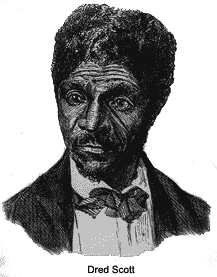The background of the Dred Scott decision, one of the Supreme Court’s most controversial pronouncements, is complex.
 Dred Scott, a slave, had been purchased by army surgeon John Emerson, a citizen of Missouri. Scott and his master had spent time in Illinois and the Wisconsin Territory, where slavery was prohibited.
Dred Scott, a slave, had been purchased by army surgeon John Emerson, a citizen of Missouri. Scott and his master had spent time in Illinois and the Wisconsin Territory, where slavery was prohibited.
After Emerson’s death in 1846, Scott sued for his freedom, claiming that his journey to free soil had made him free. He lost this case in the state courts. Scott then ended up in the possession of John Sanford, a New York abolitionist, who assisted in taking his case to the federal courts since the matter now involved a dispute between the residents of different states. The case eventually reached the Supreme Court where a decision was reached in 1857.
The Supreme Court, like the country itself, was split along sectional lines. One justice maintained that the matter belonged back in the state courts. Liberal justices argued that Scott should be freed under the terms of the Missouri Compromise. Conservative justices wanted to deny freedom to Scott and rule the Compromise unconstitutional.
In the end the Court was unable to reach a single decision, but the positions taken by Chief Justice Roger B. Taney, a former slaveowner, prevailed. He found that:
It is true, every person, and every class and description of persons who were at the time of the adoption of the Constitution recognized as citizens in the several states, became also citizens of this new political body; but none other; it was formed by them and for them and their posterity, but for no one else.Having given Europeans present in 1787 and their descendents the right of citizenship, he accepted that those Europeans could extend an offer of new citizenship to immigrants of similar background, but he denied that this could be done for African slaves of their descendants.
They had for more than a century before been regarded as beings of an inferior order and altogether unfit to associate with the white race, either in social or political relations; and so far inferior that they had no rights which the white man was bound to respect; and that the Negro might justly and lawfully be reduced to slavery for his benefit. He was bought and sold and treated as an ordinary article of merchandise and traffic whenever a profit could be made by it. This opinion was at the time fixed and universal in the civilized portion of the white race.Taney accepted that states, being independent, could grant state citizenship to blacks, but this would not confer United States citizenship. Consequently, if the federal government passed the Fugitive Slave Act under the powers given it by the United States Constitution, it and it alone could decide whether it would apply to fugitive slaves in free states. States could not interfere.
News of the Court’s decision swept the country and provoked generally predictable responses. The Republicans were outraged and saw the decision as a threat to their party, but in the end they actually profited because many moderates came to the support of the new party.
The Democrats were irreparably split into Northern and Southern factions. Stephen A. Douglas opposed the decision because it voided his solution of popular sovereignty.
On the other hand, President James Buchanan greeted the decision favorably in hopes that that the slavery issue could be put to rest. Critics of the president charged that he had actually conspired to shape the Court’s response.